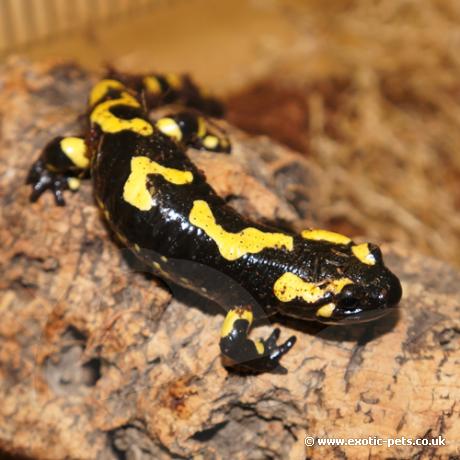

The Fire Salamander is Europes most well known species. They have black bodies with bright yellow markings. They are active during the evening and night in search for small insects.
| Origin | Central and Southern Europe, Africa and Asia |
|---|---|
| Environment | Woodlands |
| Adult size | 12 Inches |
| Suitability | Beginner |
| Life Span | 10 Years+ |
| Temperament | Docile |
The Fire Salamander has a black body with striking bright yellow variable patterning. The colours of the salamander are to warn off any potential predators that they secret a toxin when bitten or aggravated. They are rubbery to the touch and not slimy like most people would think. Some species of Fire Salamanders can grow as large as 30cm (12”) from head to tip of tail.
The Fire Salamander has a large range and can be found in central and southern Europe through to Africa and western Asia. During the day, the Salamander will hide within loose rocks, fallen rotting wood and old rodent burrows. They require a cool and moist enviroment on the forest floor.
To house one Fire Salamander, an escape proof enclosure of at least 90x38x30cm (36x15x12“) is required, increase this to 120x 38x30cm (48x15x12“) if you would like to house a pair. A layer of peat approx 2” deep should be provided covered with moss, leaves and rotting wood, this will help to keep the temperature cool. Plenty of hides should be provided, the use of cork bark, flower pots, reptile caves are ideal.
You should aim to keep the enclosure at a low temperature of 15-20C (60-68F). This means that heating isn’t usally required and room temperature suits them. A shallow water dish sunk into the ground is required, ensure this is not too deep as Salamanders can easily drown, the use of pebbles can be used as a slope. De-chlorinated water is a must and there are several ways to obtain this. Tap water must have a treatment added to remove harmful chemicals or this must be left to stand for at least 24hrs before use. Bottle water is a good idea or better still, why not use clean, fresh rainwater.
Feeding a Fire Salamander is very easy, as they will eat garden insects during the summer months. These range from worms, slugs, spiders and possibly woodlice. During the winter, crickets and wax worms can be purchased. Do not offer your salamander large foods as they often think they can manage it, when in fact they can’t! Feed every 2-3 days on as many insects as your Salamander will eat in one sitting. Earth worms and the odd insect can be left in for the Salamander to find and eat at it’s own leisure.